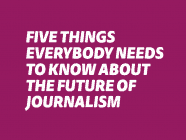News is growing more negative. Research shows this is a a growing trend in political news and articles. Researchers argue that the political stories are commonly framed negatively, and the cynical coverage appears focused on the conflicting aspects of politics. However, is the increase of negative political coverage dictated by the newsrooms or is it a result of readers’ preferences for negativity?
This is the issue studied by Marc Trussler at Vanderbilt University and Stuart Soroka at McGill University, who argue reader’s preferences (demand-side of news), is more important than news provider’s preferences (supply-side of news). They demonstrate that the readers, indeed, prefer the negative political news.
According to Trussler and Soroka, the supply-side explanations concerning historical events such as Vietnam War and Watergate scandal that heralded the era of negative coverage within U.S. are unlikely factors to influence reader’s choices outside the United States. Similarly, the other explanation that newsrooms prioritize exciting information also does not fully explain the negativity of political coverage. These factors lead the researchers to the probe the reader’s behavior. Although, previous surveys suggested that the public does not enjoy negative news, in practice their behavior is often contrary to their own perception of such behavior. Therefore, to answer the research question, Trussler and Soroka have preferred to examine news choice directly, focusing on behavioral data instead of relying only on questionnaires.
To observe the preferences, the researchers collected groups of up to six participants allowing them to freely choose from a set of news articles while concealing the true intent of the study from the readers. The articles were chosen from an artificially designed news database that included about 50 stories on Canadian politics among which 30 articles were randomly drawn and presented in a random order to each respondent on a Web page. Each of the article was coded for tone (positive, negative or neutral) and for topic (policy, strategy, neither).
The findings highlight that negative stories were chosen 10.5 percent of the time, compared with 9.1 percent for neutral stories and 8.5 for positive ones, as expected. Results also revealed that, despite the expectations, stories on political strategy were selected only 7.6 percent of the time, while government policy stories 10.5 percent of the time. The joint results also suggest that strategic stories are comparatively unpopular when they are positive, and that policy stories are most popular regardless of their tone.
The researchers examined the relationship between observed behavior and stated preferences by asking the participants post-experiment whether media is too negative about politicians and politics and whether they would like to see more stories focused on polls and political competition. The findings from the answers to the survey questions show the disjuncture between attitudes and behavior noted in previous work. Thus, if a certain survey finds that media consumers want less negative stories, it does not necessarily mean that the respondents do that in practice.
In conclusion, the researchers suggest the importance of concentrating on demand-based accounts of media content, and a focus on negative yet constructive political news. This approach plays an even greater role in the competitive Internet media environment where consumers’ choice is greater and the competition tougher. Thus, the balance between economic viability and journalistic integrity is a strategic challenge in news-making: Reporting objectively on politics and matching it with readers’ preferences.
Source: Consumer Demand for Cynical and Negative News Frames by Marc Trussler and Stuart Soroka (The International Journal of Press/Politics, 18 March 2014)
Photo credit: marsmett tallahassee / Flickr Cc
Tags: coverage, cynical, media, Media Consumers, negative, News, Politics, readers, Research












































